EDITOR’S NOTE: Traveleater BJ Young has been living in Shanghai for over 15 years and spills the beans on what dishes to eat on your next visit to Shanghai.
After many years living in Shanghai, there are now very few culinary delights that I’m not able to track down in my adopted city. This is because all manner of chefs and cooks from the farthest corners of China and the world come to Shanghai, to open or work at restaurants or try to make it big feeding the world’s most populous city.
But despite having so much choice, there are a few dishes that I find myself returning to time and time again, even after 15 years. With the help of my Shanghainese colleagues, I’ve compiled a list of 25 things to eat in Shanghai that we love, for food pilgrims to experience what eating is like in our city.
FOOD IN SHANGHAI QUICK LINKS
Eating at local restaurants is great, but so is going on a food tour. Check out some of the most popular food-related tours and activities in Shanghai.
TOURS & OTHER SERVICES
- Food Tour: 3-Hour Local Food Tasting Tour
- Tea and Dessert Tasting: Shanghai 3-Hour Afternoon Tea Tasting and Dessert Tour
- eSIM: China eSIM
Save This on Pinterest!
No time to read this Shanghai food guide now? Click on the save button and pin it for later!
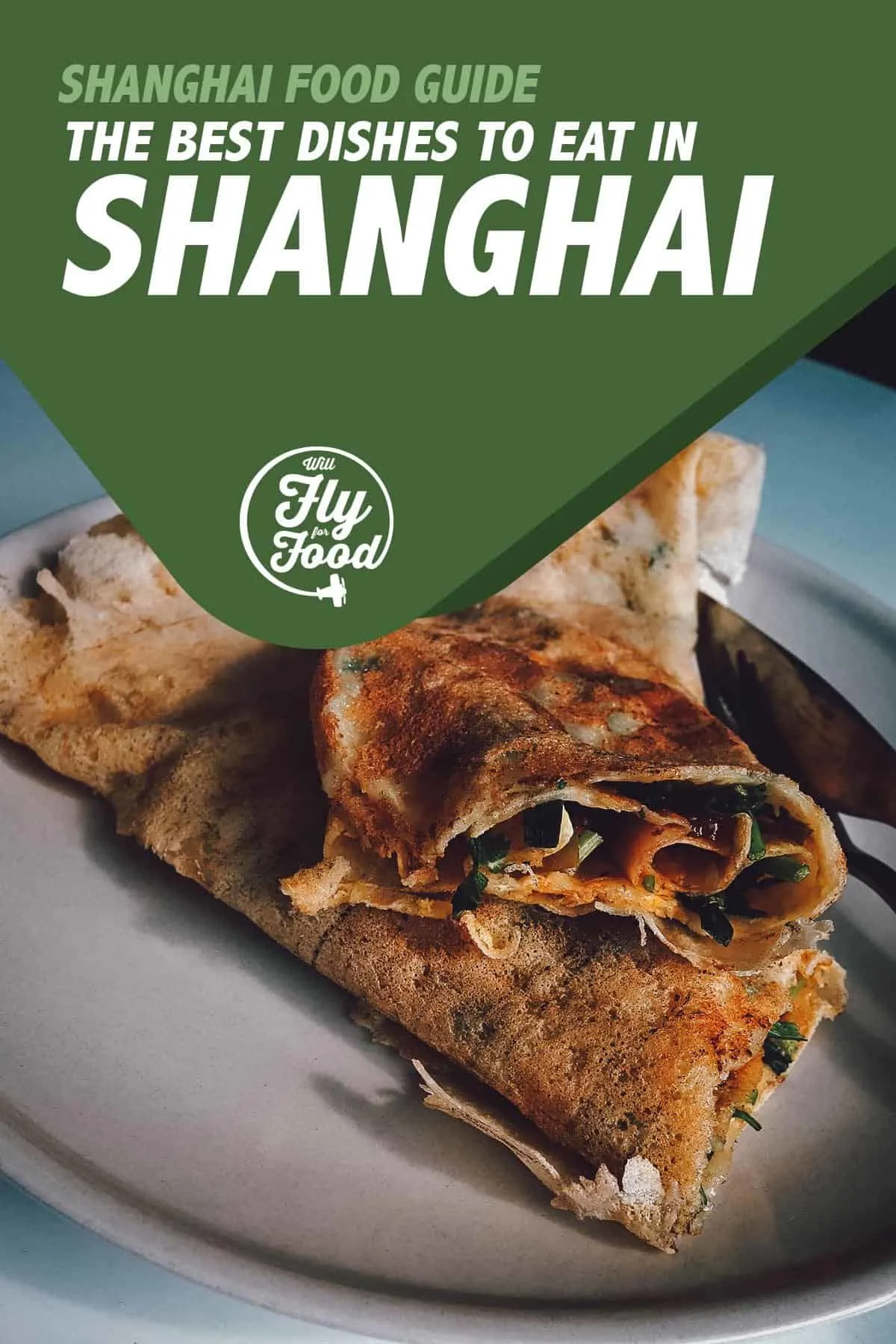
WHAT IS SHANGHAI CUISINE?
Shanghai cuisine is a popular style of Chinese food. In the strictest sense, it refers to what’s known as Benbang cuisine – a style of cooking that originated in Shanghai – but it can also refer to the styles of cooking of the surrounding Jiangsu and Zhejiang provinces.
Traditional Shanghai cuisine makes use of various cooking methods and condiments to create dishes that are lighter, mellower, and a little sweeter compared to other regional Chinese cuisines. Sugar and soy sauce are important ingredients while sweet and sour is a typical Shanghai taste. Seafood is abundant and rice is generally preferred over noodles.
With increased globalization, foreign influences have made their way into Shanghai Chinese food and given rise to a curious style of fusion cooking known as Haipai cuisine. It combines regional Chinese and Western cooking traditions to create unique dishes like Shanghai-style borscht, fried pork chops, and potato salad.
THE BEST FOOD IN SHANGHAI
To make it easier to digest, I’ve categorized this Shanghai food guide and included the dish names in Chinese characters as well as in pinyin for easier ordering. Click on a link to jump to that section.
If you are unsure of the Chinese tones, perhaps try saying the pinyin really really fast (like I do when I try out unfamiliar Chinese words), and half the time the food vendor will figure it out.
MUST-TRY SHANGHAI DISHES
These first three dishes are the heavy hitters that appear on every must-eat Shanghai food list. So let’s get these out of the way:
1. Shanghai Soup Dumplings (xiaolongbao 小笼包 or tang bao 汤包)
These paper-thin dumplings are filled with meat and piping hot soup lying in wait to scald the uninitiated. They’re best dipped in vinegar and julienned ginger, and seriously good.
Shanghai soup dumplings are available in most Shanghai restaurants, but many head to one of the branches of Din Tai Fung for its consistent quality.
RECIPE: Xiaolongbao
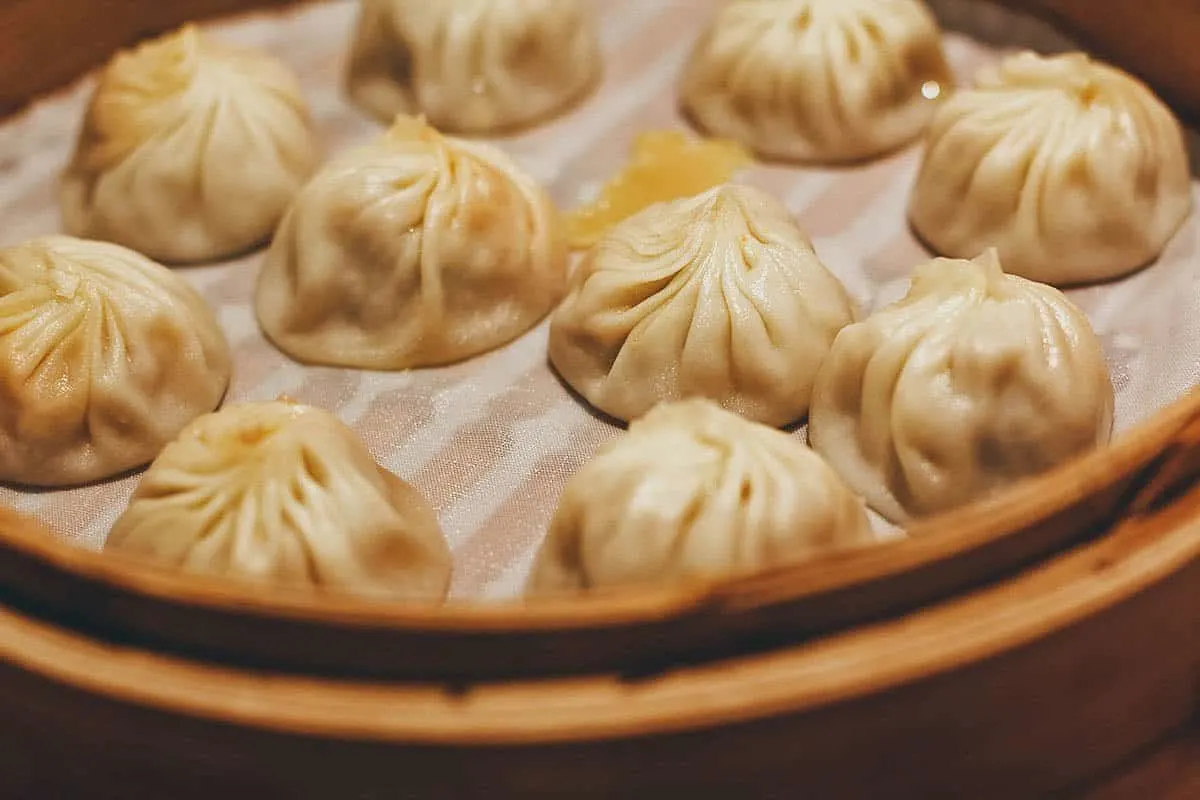
A word of caution, learn how to properly eat xiaolongbao lest you don’t mind burning the inside of your mouth. Many Shanghai restaurants like Din Tai Fung will teach you proper technique.

2. Shanghai-Style Braised Pork Belly (hong shao rou 红烧肉)
This is another dish that no self-respecting Shanghai restaurant menu could ever be without. Tender pork belly cubes are doused in a sweet and sticky sauce – a mixture of vinegar, soy, and sugar that come together in a vibrant red color, hence the Chinese character “hong” (红) in the name.
Hong shao rou perfectly showcases the Shanghainese fondness for mixing savory or sour with blasts of sweet.
RECIPE: Hong shao rou

“Hong Shao Rou” by Ruocaled, used under CC BY 2.0 / Processed in Photoshop and Lightroom
3. Steamed Hairy Crab (qing zheng da zha xie 清蒸大闸蟹)
Come late September/early October, the entire city of Shanghai will be in a tizzy with the arrival of this scarce delicacy from nearby Yangcheng Lake, especially the prized crab roe.
Tedious to de-bone (or is it de-clawed?) and definitely not wallet-friendly, having this dish for dinner is nonetheless a big event that Shanghainese look forward to every autumn. For the O.G. of hairy crab Shanghai restaurants, head to Wang Bao He on Fuzhou Road (福州路603号).
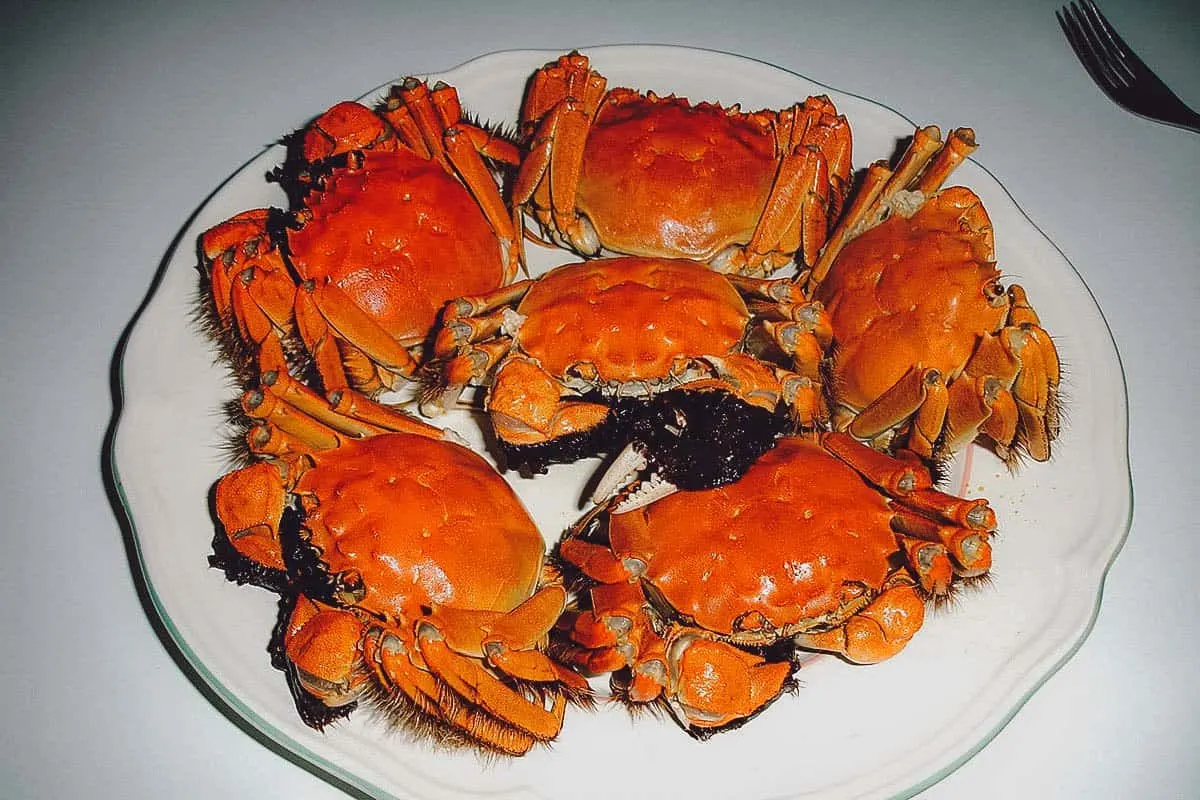
J. Patrick Fischer / CC BY-SA / Processed in Photoshop and Lightroom
SHANGHAI CHINESE BREAKFAST
Breakfast time is an absolute bonanza for Shanghai street food carts. With droves of worker drones in need of quick sustenance, nearly every downtown street will be buzzing with humble mobile carts, and restaurants will open to the street with breakfast options to grab and go. For serious Shanghai street food lovers, 8-10AM is the optimal time for foraging.
4. Shanghai Shao Mai (烧卖)
Less well-known than its Cantonese cousin – the dim sum mainstay shumai – Shanghai’s version is filled with sticky rice and shaped like a bell, with a small neck and a big, round bottom.
Fillings may include pork, bamboo shoots, shrimp and lamb, but my favorite is the one stuffed with a cooked egg yolk and threads of crab. I grab this at the convenience store in the mornings, but my local colleagues never fail to scoff that the only acceptable shao mai are the ones at Baiyulan 白玉兰on Tianyaoqiao Road 天钥桥路98号.
RECIPE: Shanghai Shao Mai
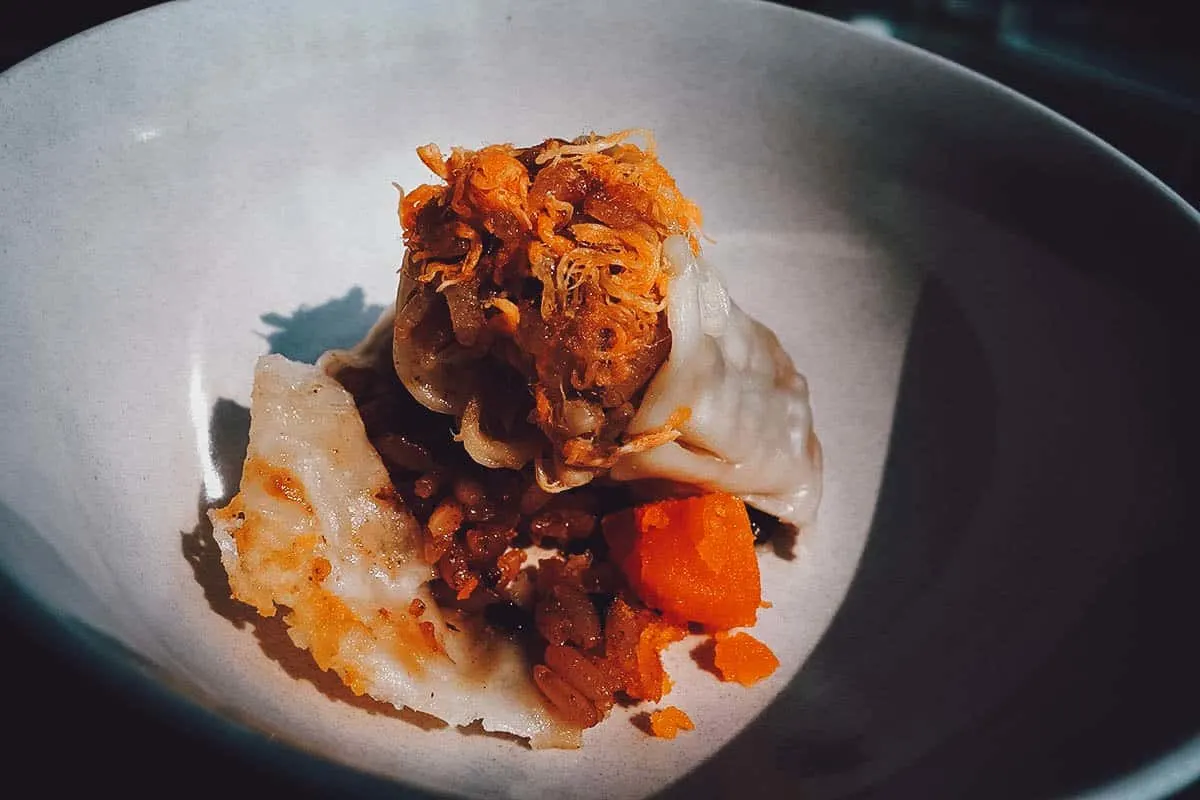
5. Deep-Fried Dough (youtiao 油条)
Often served with rice congee, youtiao is basically a savory version of a churro, if the churro were bigger and airier. Its name literally translates to “oil strip”, but the Cantonese have an even better name which translates to “oil-fried devil”. Enough said.
RECIPE: Youtiao
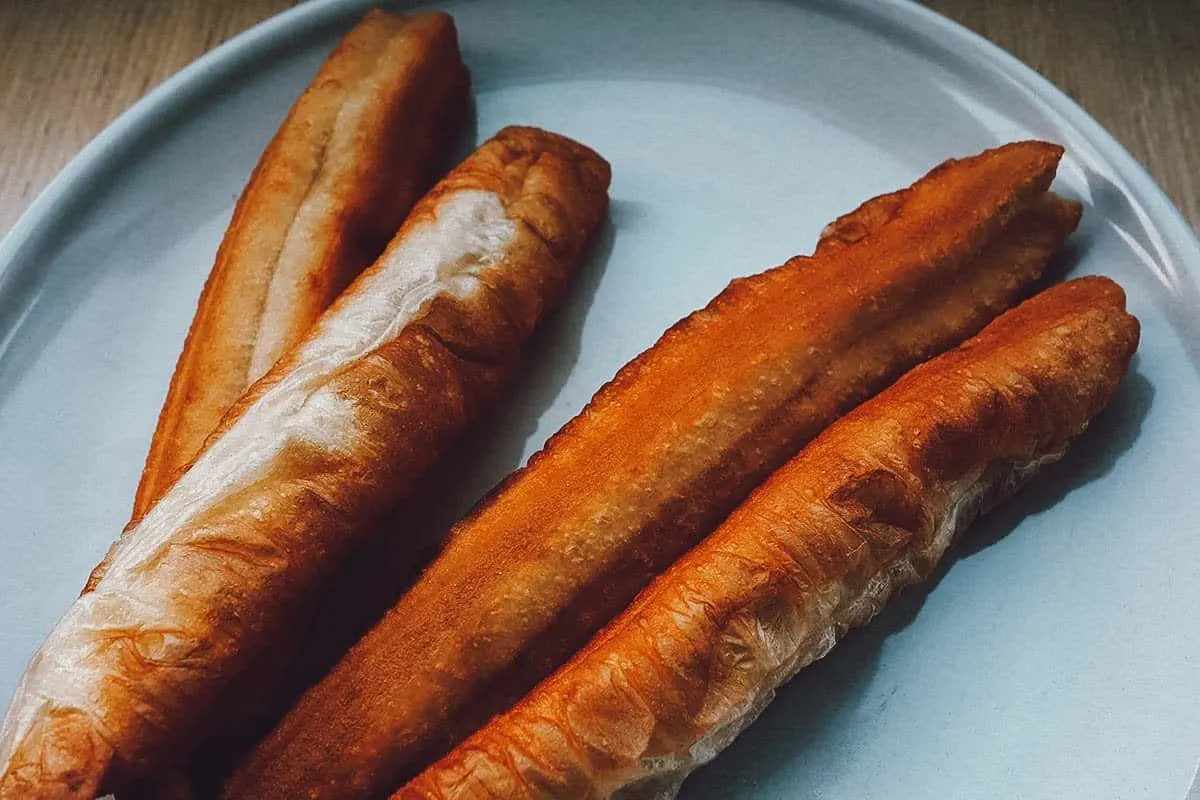
6. Egg Pancake (dan bing 鸡蛋饼)
Originally from Nanjing, this is a breakfast burrito, Chinese style. The wrap is made of egg mixed with a little water, flour and cornstarch, grilled until a bit crispy on the outside but still chewy on the inside.
In goes a tangy hoisin-flavored sauce and a choose-your-own-adventure spread of fillings, from the wonderful to the weird: chicken, back bacon, hotdogs, potato slivers, tofu skin, seaweed, scallions and wickedly spicy sauce.
RECIPE: Ji dan bing

The queues are always long for this, the ultimate Chinese breakfast! Thankfully, there’s a dan bing stall on practically every street.
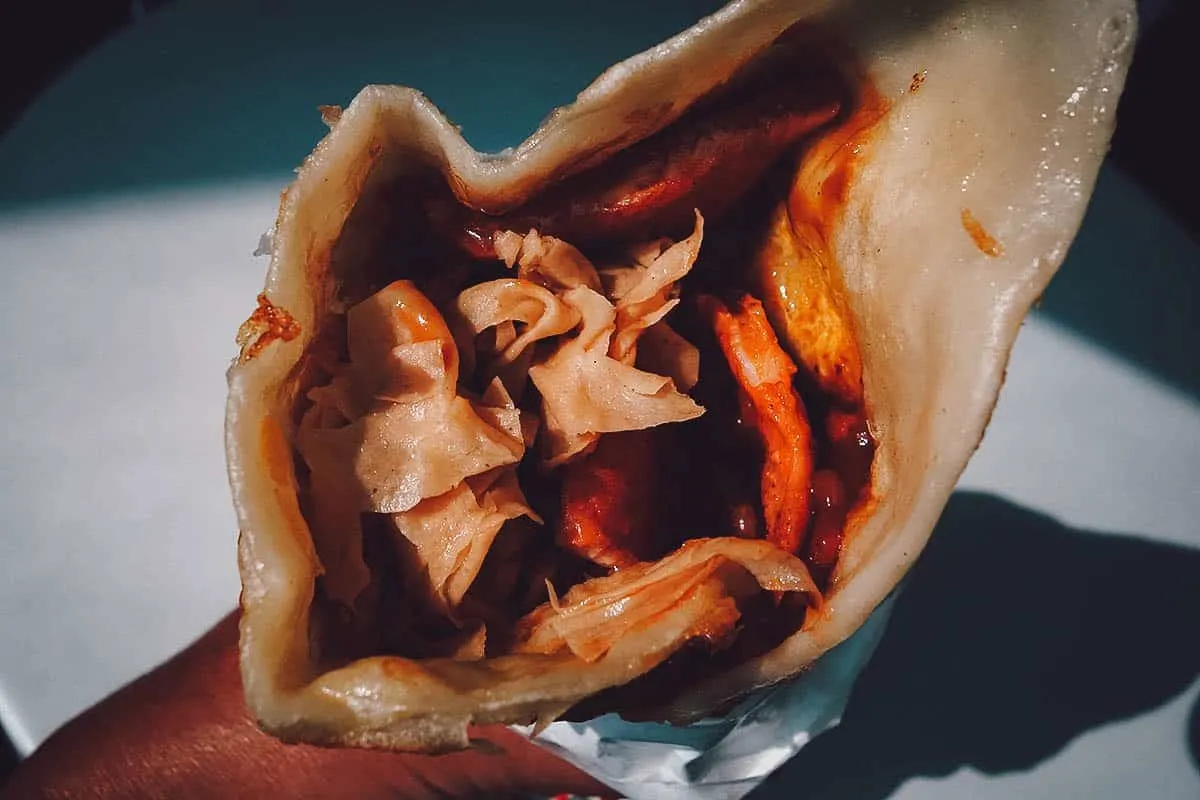
7. Shandong Pancake (shan dong jian bing 山东煎饼)
If dan bing were a burrito, then Shandong pancake would be a crepe. Just like a crepe, the Shandong jian bing is paper-thin and cooked till crispy on a custom flat round grill. No oil is added to the grill, so it’s less greasy than its Chinese burrito cousins – unless, of course, you opt to add a youtiao fried dough stick in the middle.
RECIPE: Jian bing
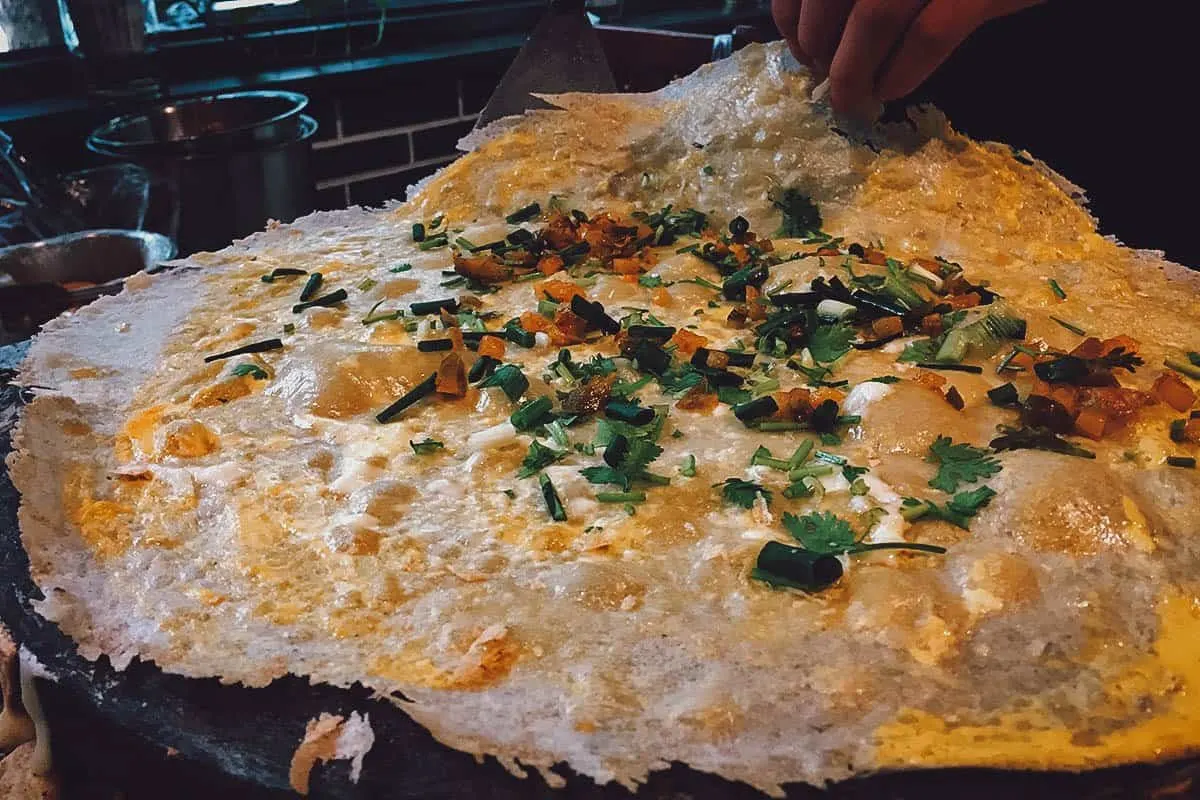
Other common fillings are egg (cracked then spread over the entire surface of the crepe while it’s cooking), chicken, scallions and lettuce leaves, with a slather of hoisin sauce. This is often sold by the same street food stalls offering egg pancakes.

8. Scallion Pancake (cong you bing 葱油饼)
Unlike the dan bing and the Shandong jian bing, which originated somewhere else in China, the scallion pancake is pure Shanghai. The dough is coiled then flattened like a cinnamon roll, with maximum layers to ensure flakiness.
Two pancakes are slapped together with a generous filling of scallions and a not-so-secret ingredient, pork fat, in the middle. The oily-fried-devilishness of this type of Chinese pancake is probably why fewer street food stalls in Shanghai sell them these days.
RECIPE: Cong you bing

9. Soy Milk (doujiang 豆漿)
Together with shao mai, fried dough sticks and pancake anything, soy milk is the final member of Shanghai’s undisputed Four Kings of Chinese Breakfast. This milky extraction of soybean is as ubiquitous in Chinese breakfast tables as cow’s milk is in western households.
Available cold or hot (the hot version being far superior), doujiang is mildly sweet and surprisingly very filling as a standalone breakfast. It’s usually sold by the same street food stalls offering pancakes or steamed buns.
RECIPE: Doujiang

10. Steamed Buns (baozi 包子)
Baozi refers to a family of steamed buns made with a variety of fillings. Minced pork is the most common ingredient, but do try the vegetable version and the red bean paste.
Baozi are cheap and cheerful and found in many small Shanghai street food stalls. Just look out for the huge bamboo steamers.
RECIPE: Baozi

SHANGHAI STREET FOOD & SNACKS
Many of the Chinese breakfast dishes mentioned above can also be categorized as Shanghai street food. Here are a few more that aren’t typically eaten for breakfast.
11. Crab Shell Pie (xie ke huang 蟹壳黄)
The “poor man’s hairy crab” that is not a crab at all, these savory or sweet pies get their name from their resemblance to a cooked crab shell.
Oven baked and golden brown and about the size of a hockey puck, the outer layer is flaky and sprinkled with toasted sesame. Common fillings include sugar or onion or a vegetable I have yet to identify whose name translates to “taste of moss.”
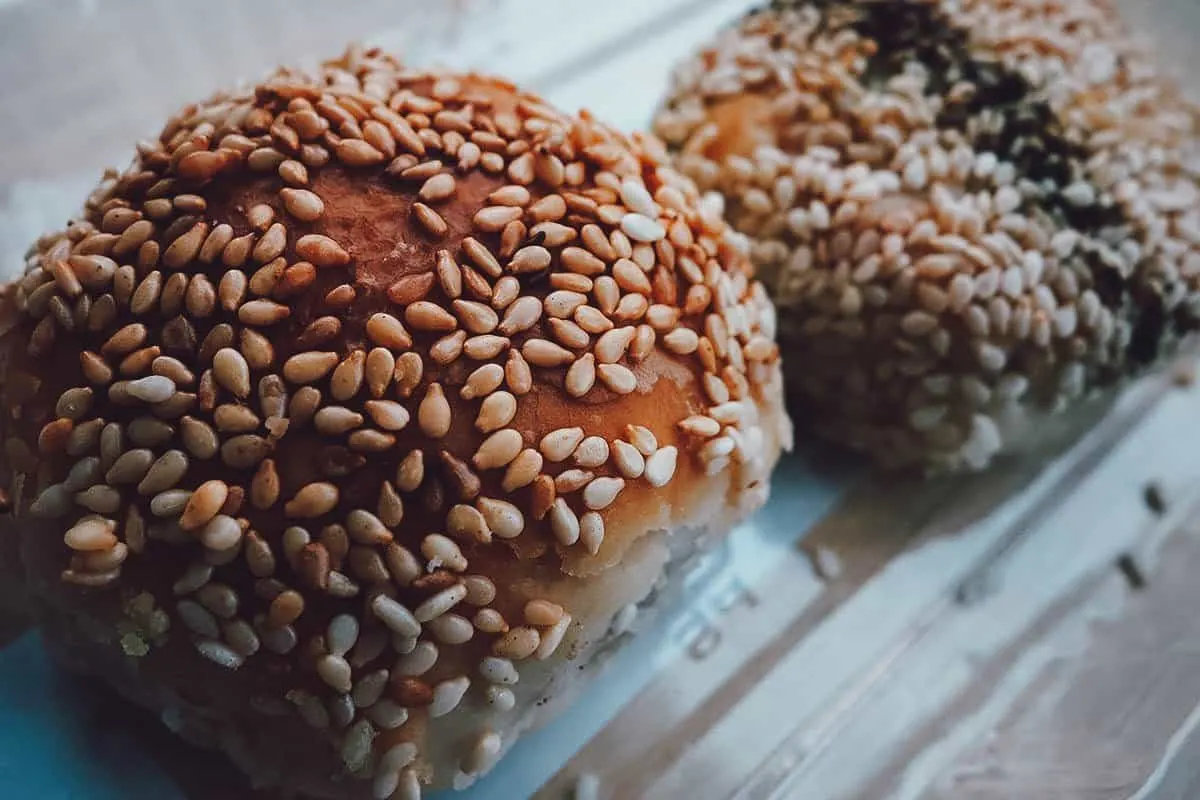
True-blue Shanghainese will line up for hours at Wang Jia Sha Dimsum Shop 王家沙点心店 on 805 West Nanjing Road 南京西路805号, but I cheat and buy them online through their TMall store.
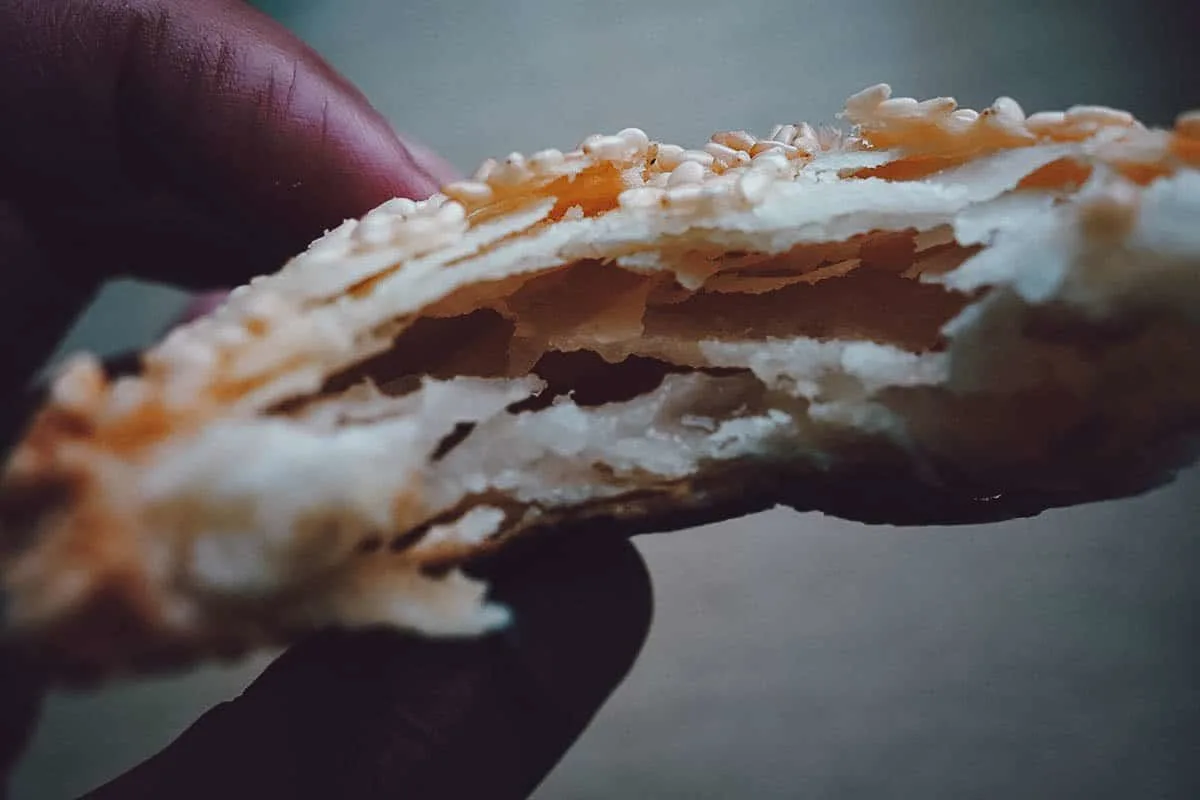
12. Pan-Fried Pork Buns (sheng jian bao 生煎包)
This is another one of those deceptively simple-looking dishes that packs a powerful taste punch in a cheap, cheap price tag. The sheng jian bao is the pan-fried version of the soupy xialongbao, with succulent pork and scalding broth inside a chewy, thick-walled bun with a fried, crispy and golden brown bottom.
I reckon the best-value lunch to be had in Shanghai is a standard order of four pieces of sheng jian bao at Yang’s Fry Dumplings (many locations throughout the city).
RECIPE: Sheng jian bao
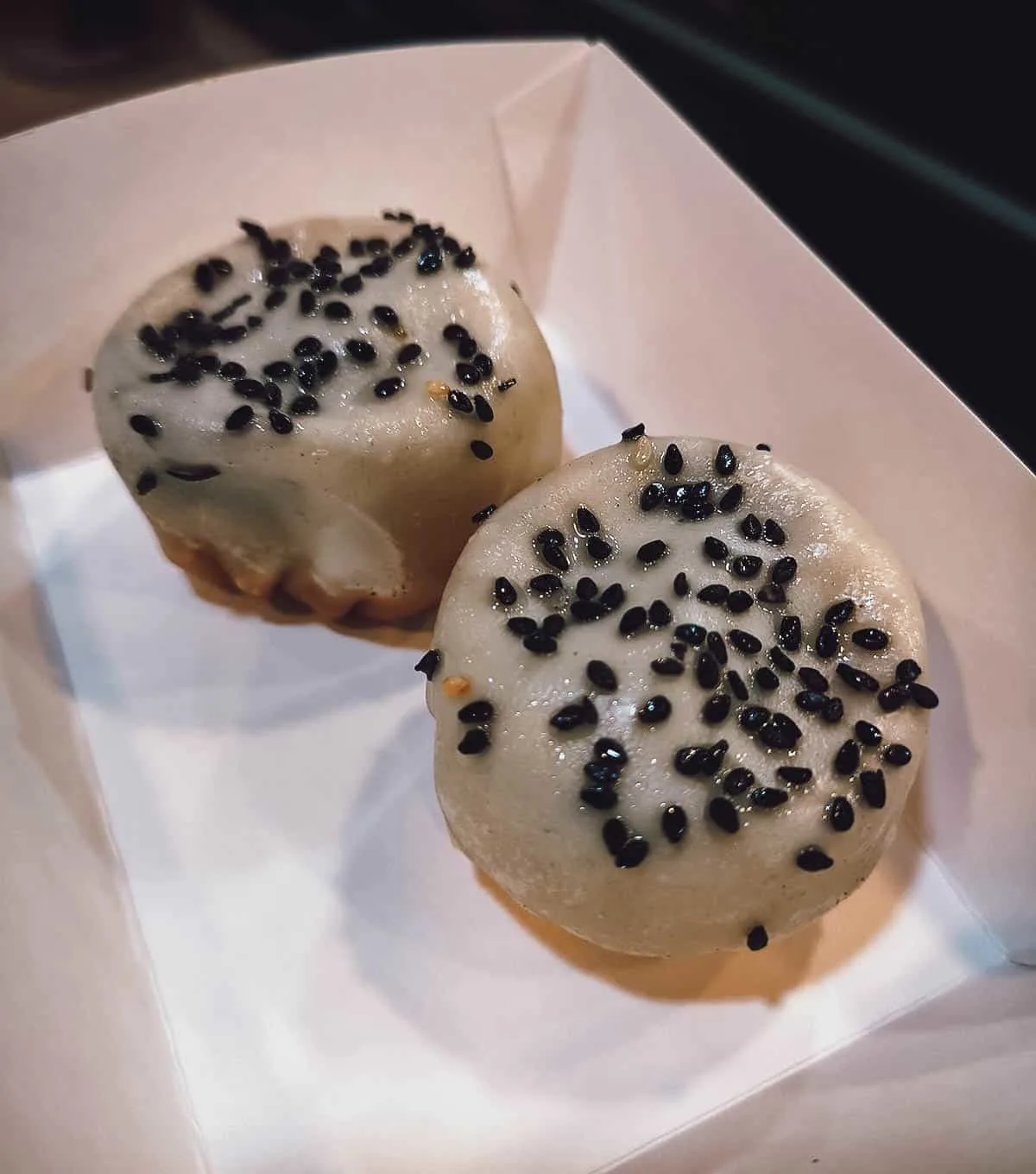
13. Xinjiang Lamb Skewers (yang rou chuan 羊肉串) and Uighur Flatbread (nang bing 馕饼)
Tender, juicy cubes of lamb kebab, coated with cumin and paprika, paired with flatbread hot out of a tandoor oven. This is probably one of the most popular snack foods to come out of the Turkic ethnic group from the far northwest.
These are harder and harder to find as rapid development pushes away small street food vendors in Shanghai, but you can certainly find them every Friday at the Muslim Market, where a foodie paradise materializes outside Huxi Mosque after Friday prayers. Just go to 1328 Changde Road near Aomen Road (1328常德路近澳门路).
RECIPE: Yang rou chuan
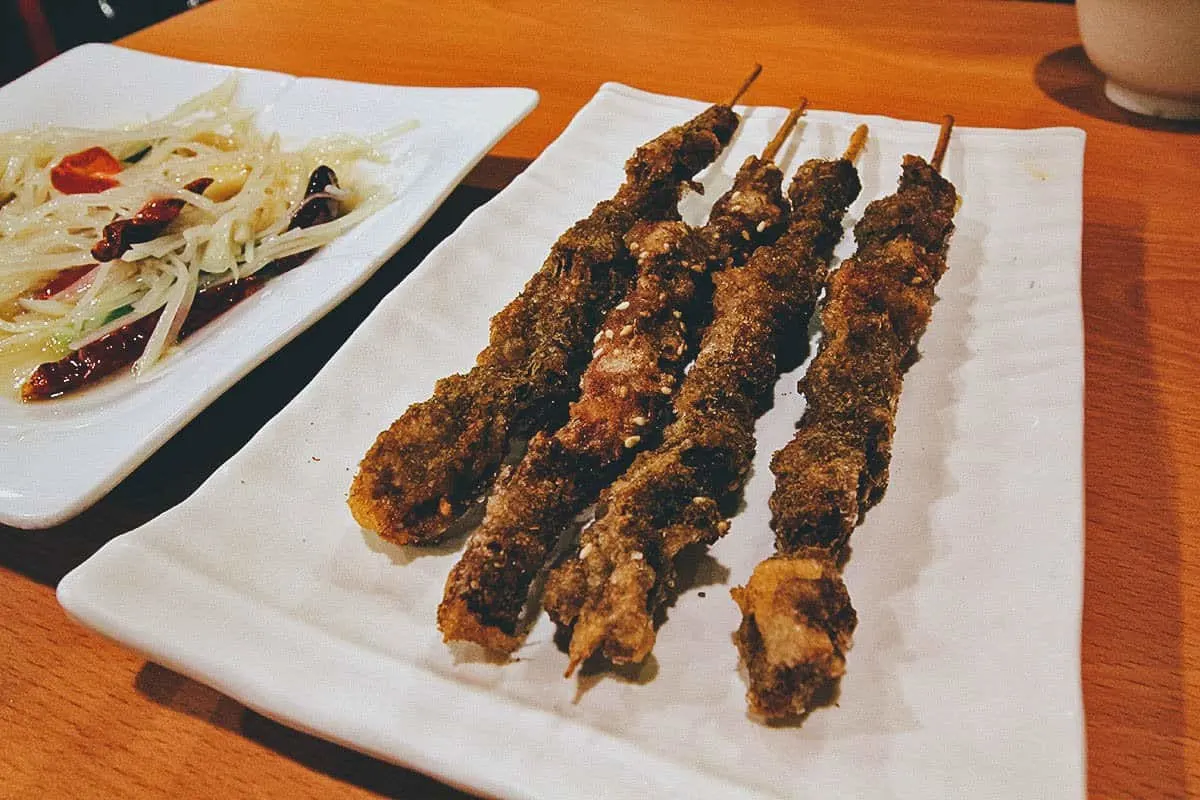
SHANGHAI RESTAURANT SMALL DISHES
The next two categories describe dishes that can typically be found at Shanghai Chinese restaurants.
14. Braised Wheat Gluten with Mushrooms (kao fu 烤麸)
It sounds weird, it looks weird, and it has a seemingly unappetizing mix of parts – tofu-like wheat gluten, fermented black beans, boiled peanuts and wood ear mushrooms – that may make you say “Thank You, Next!”
But honestly, it’s delicious, and this is one of the few no-meat dishes that don’t leave me wanting.
RECIPE: Kao fu
15. Dates Stuffed with Glutinous Rice (xin tai luan 心太軟)
Xin tai luan (which literally translates to “the heart is too soft”) are pitted dates softened in water then stuffed with sticky rice, served warm. Although this dish is sweet, it is always served as an appetizer. This is a Shanghai food classic.
RECIPE: Xin tai luan
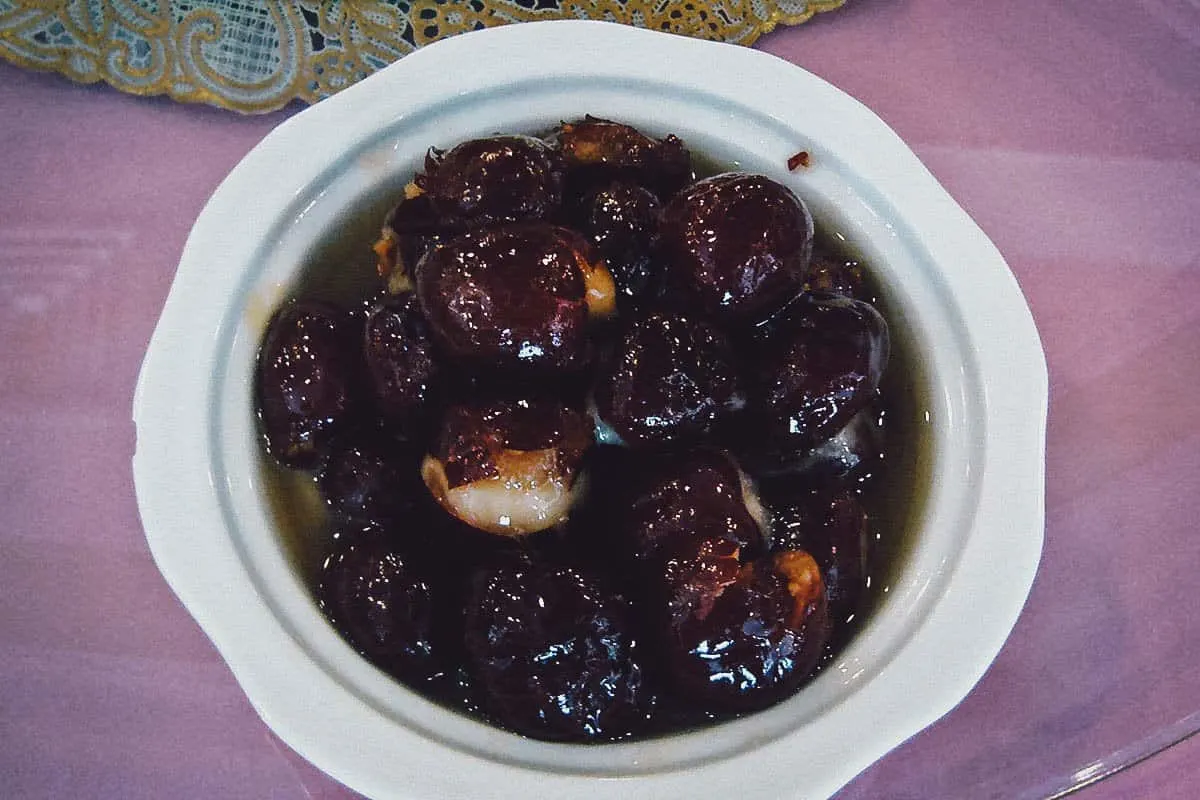
“Dates stuffed with sweet rice flour” by Kent Wang, used under CC BY-SA 2.0 / Processed in Photoshop and Lightroom
16. Ma Lan Tou Spiced Tofu (ma lan tou xiang gan 马兰头香干)
This is a quintessentially Shanghai cold appetizer which I’ve never seen anywhere else. A fragrant vegetable with an herb-like taste, ma lan tou is combined with dry spiced tofu, chopped into small cubes.
It’s often served fancy-like by packing into a small bowl then inverting the molded contents onto a plate. This is another dish that I never fail to order because it’s both very tasty and elusive outside of Shanghai.
RECIPE: Ma lan tou

“Ma Lan Tou at Gourmet Noodle House” by Gary Stevens, used under CC BY 2.0 / Processed in Photoshop and Lightroom
17. Stir-Fried Pea Shoots (dou miao 豆苗)
Dou miao is my number one favorite green leafy vegetable of all time. It is most commonly prepared very quickly sauteed with garlic, because when something is so good to begin with, you don’t mess with it.
Dou miao is only available during the winter months, so when it shows up on Shanghai restaurant menus again, it’s always incredibly fresh. YUM!
RECIPE: Dou miao

stu_spivack / CC BY / Processed in Photoshop and Lightroom
18. Crispy Fried Eel (su jian shan yu 酥煎鳝鱼)
Popular during the Qing Dynasty, this dish has been around for over a century. Twice-fried, extra-crispy boneless strips of eel with a thick and sticky brown glaze – crunchy and salty-sweet, it’s the very definition of more-ish.
SHANGHAI RESTAURANT MAINS
19. Stir-Fried River Shrimp (qing chao he xia 清炒河虾)
This is a very delicate Chinese dish that goes by the more appropriate name Crystal Shrimp. These river shrimp are smaller, sweeter, and juicier than any shrimp I’ve ever tasted. Minimal ingredients are added to highlight their freshness, but a light dip in vinegar adds just the right flavor punch.
20. Yellow Croaker Noodle Soup (huang yu mian 黄鱼面)
Admittedly, this is not my favorite fish dish in China; I prefer the squirrel-shaped mandarin fish. But the Shanghainese absolutely love yellow croaker!
It stays juicy and tender no matter how long it’s cooked. In this dish, chunks of yellow croaker sit atop a bed of springy noodles in a creamy, yellow-gold broth with a hint of sourness from vinegar.
If you are doing the tourist thing at Xintiandi, grab a bowl at Xie Huang Yu 蟹黄鱼 (太仓路200号) but avoid peak lunch or dinner hours.
21. Squirrel-Shaped Mandarin Fish (song shu gui yu 松鼠桂鱼)
Originating from nearby Suzhou City, to call this a mere sweet and sour fish does injustice to its artful presentation.
The body of a Mandarin fish is carefully scored before deep-frying so that it stands straight out to resemble what is described as a “squirrel” shape (which I honestly don’t see, but who cares, it’s so pretty) before being covered with sweet-sour tomato sauce and pine nuts.
The scoring makes it extra crispy and good-looking that it has earned a permanent place in every fancy Shanghai Chinese restaurant.
RECIPE: Song shu gui yu
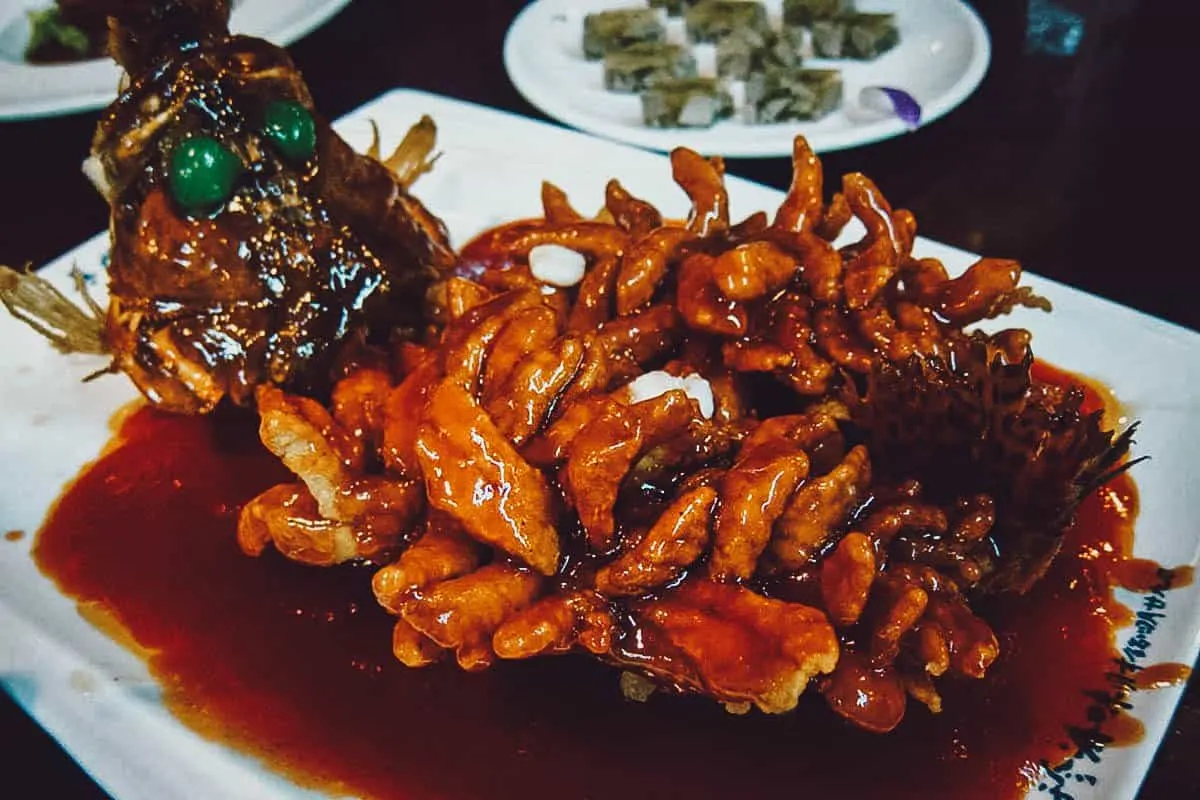
Charles Haynes from Hobart, Australia / CC BY-SA / Processed in Photoshop and Lightroom
22. Old Jesse’s Clay Pot Rice with Crab (xie huang lao fan 蟹黄捞饭)
For this particular dish, don’t go anywhere else except to the famous Shanghai restaurant, Old Jesse or Lao Ji Shi (老吉士). This hole-in-the-wall is always cramped, it’s always busy, and the staff alternate between ignoring you and rushing you to make room for the queue.
Many say it’s way overrated. But Old Jesse is the home of a Chinese dish that I think is mind-blowingly delicious: a pot of rice in a sizzling clay pot, the bottom bits charred and crispy, and the top generously smothered with picked crab meat and roe, finished with a little vinegar and ginger. It’s a flavor and texture bomb that will never disappoint. Go to the original restaurant on Tianping Road (天平路41号).
23. Old Jesse’s Crab Anything Dishes
While we’re at it, anything with crab at Old Jesse is a crowd pleaser, even outside peak crab season. There’s crab with bean curd, crab with vermicelli noodles, crab soup, drunken crab, yada yada.
You can probably order all the appetizers and mains on this list while you are there, and Old Jesse’s version can compete with the best. Just be sure to reserve well in advance; there are only two seatings, at 6:30PM and at 8:30PM.
SHANGHAI DESSERTS
And lastly, just a couple of desserts to try in Shanghai, one classic Chinese and the other not so much.
24. Glutinous Rice Balls (tang yuan 汤圆)
Translating as “soup balls”, this dessert of pillow-y soft sticky rice balls stuffed with black sesame paste is basically mochi swimming in a bowl of ginger and osmanthus soup.
Each bite brings out a burst of fragrant black sesame, whose warmth and sweetness pairs perfectly with the cold and slightly tangy soup. Hot and cold, slightly sweet and slightly tangy, this is hands down my favorite Chinese dessert.
RECIPE: Tang yuan
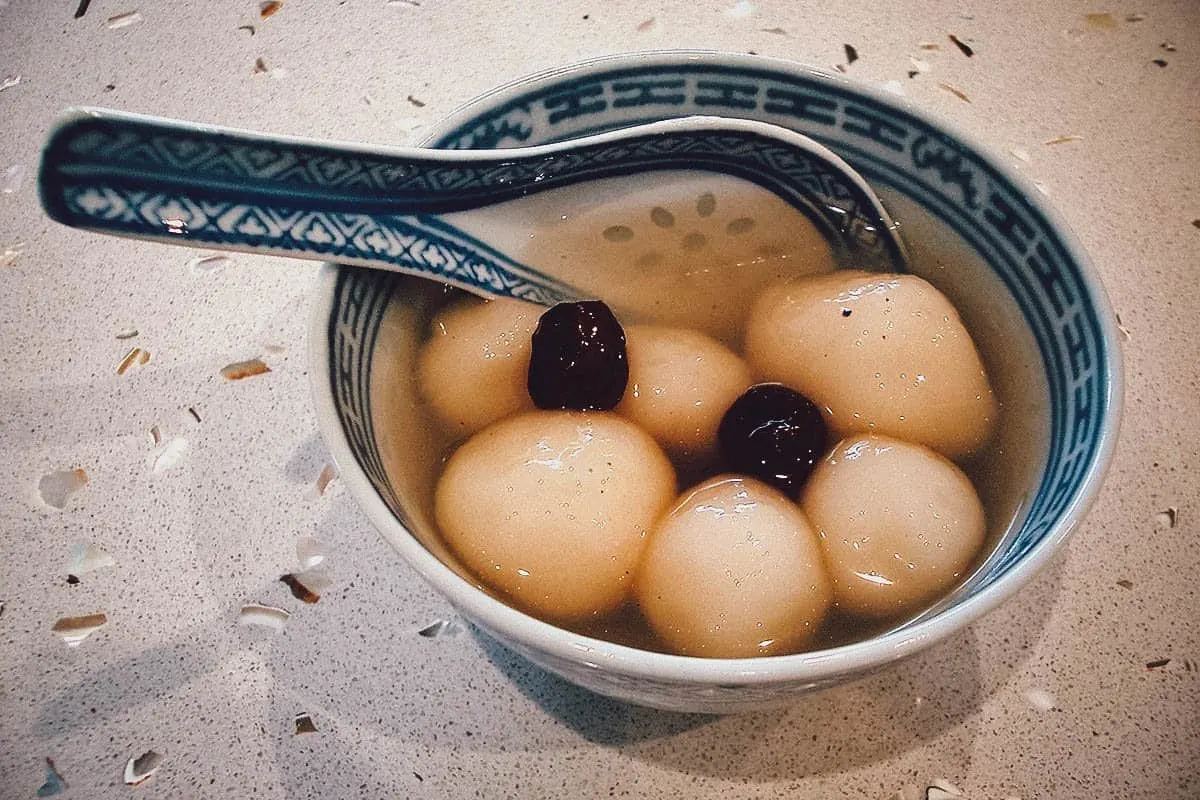
“Tang Yuan 汤圆” by Alpha, used under CC BY-SA 2.0 / Processed in Photoshop and Lightroom
25. Mr. & Mrs. Bund’s Lemon Tart
Okay, this is not a Chinese dish, and it didn’t even originate in China. The French chef who created this lemon tart – Paul Pairet, the very same one of Ultraviolet fame, a.k.a. the most expensive restaurant meal – sorry, I mean “sensory dining experience” in Shanghai – purportedly created this somewhere in France before he became a celebrity chef at one of the best restaurants in Shanghai.
Those who detest deconstructed and molecular anything (me) might even say it’s too pretentious. But DAMN! This lemon tart is exceptionally good. It’s also surprising, it’s clever, it’s photogenic. It is Everything.
Paul Pairet has taken a lemon, candied it in water for three days, hollowed it out then stuffed it (with the rind still unbroken, say what?) with a sour lemon sorbet, lemon curd and vanilla Chantilly.
The tart and sweet filing oozes out with the lightest piercing by a dessert fork, which is wonderful with a bite of the sweet lemon sable that accompanies the tart. It is in my opinion, the best dessert in Shanghai.
WHERE TO EAT IN SHANGHAI
Throughout this food guide are my recommendations on the best restaurants in Shanghai to try a few of these dishes. I’ve listed them below for easy reference.
DIN TAI FUNG
Shanghai Soup Dumplings (xiaolongbao 小笼包 or tang bao 汤包)
Restaurant details
WANG BAO HE
Steamed Hairy Crab (qing zheng da zha xie 清蒸大闸蟹)
Restaurant details
BAIYULAN 白玉兰
Shanghai Shao Mai (烧卖)
Restaurant details
WANG JIA SHA DIMSUM SHOP 王家沙点心店
Crab Shell Pie (xie ke huang 蟹壳黄)
Restaurant details
YANG’S FRY DUMPLINGS
Pan-Fried Pork Buns (sheng jian bao 生煎包)
Restaurant details
XIE HUANG YU 蟹黄鱼 (太仓路200号)
Yellow Croaker Noodle Soup (huang yu mian 黄鱼面)
Restaurant details
OLD JESSE (LAO JI SHI, 老吉士)
Old Jesse’s Clay Pot Rice with Crab (xie huang lao fan 蟹黄捞饭)
Anything with crab
Restaurant details
PAUL PAIRET
Mr. & Mrs. Bund’s Lemon Tart
Restaurant details
SHANGHAI FOOD TOURS
As demonstrated by this guide, no one knows the food in Shanghai better than a local. What better way to experience Shanghainese food than by going on a food tour?
A food-obsessed local will take you to the best restaurants and street food stalls in Shanghai so you don’t have to do the research, plus they’ll explain all the dishes to you in more detail. Check out Get Your Guide for a list of food tours in Shanghai.
SHANGHAI COOKING CLASSES
Aside from food tours, we also enjoy taking cooking classes when we travel. It’s a hands-on way of learning more about the local cuisine. If you enjoy cooking and would like to make Shanghainese food, then check out Cookly for a list of cooking classes in Shanghai.
FINAL THOUGHTS ON THE FOOD IN SHANGHAI
by JB & Renée
It may seem odd that we haven’t been to Shanghai or China despite my sister living there for close to two decades. After all, China is one of the world’s best countries for food.
We have our reasons for putting it off, one of them being that a trip to China just seems so daunting. It’s such a vast country with so many interesting regional cuisines that we don’t know how to begin. To truly explore the cuisine, I think a trip to China merits a minimum stay of six months.
I don’t know as much yet about China’s regional cuisines but based on what I’ve read, Yunnan and Shanxi provinces are of interest, as are Shanghai and Beijing. Among many others, Peking duck in Beijing is something we absolutely need to experience.
With so much good food to be had in China, it’s only a matter of time before we finally make that trip. And with my sister living in China’s economic capital for close to twenty years, I’m sure a good chunk of that time will be spent exploring the food in Shanghai.
As you can probably tell from this delicious article, we already have the best guide.
Disclosure
Some of the links in this Shanghai food guide are affiliate links, meaning we’ll make a small commission if you make a booking at no added cost to you. We only recommend products and services that we use ourselves and firmly believe in. We really appreciate your support as this helps us make more of these free travel guides. Thank you!



Monica Luo
Friday 21st of May 2021
Thank you for including Mr & Mrs Bund's "Lemon & Lemon Tart PP" in your article. There is a misinformation in this paragraph: "Paul Pairet, the very same one of Ultraviolet fame, a.k.a. the most expensive restaurant meal – sorry, I mean “sensory dining experience” in Shanghai – purportedly created this somewhere in France before he became a celebrity chef at one of the best restaurants in Shanghai.". In fact, Chef Paul opened Mr & Mrs Bund in Shanghai in April 2009, and continued to open Ultraviolet - the world first multi-sensory, fully immersive dining experience - in May 2012, also in Shanghai (location undisclosed). Till now Ultraviolet is the only 3 Michelin starred restaurant in Shanghai since September 2017. Thank you!
JB & Renée
Saturday 22nd of May 2021
Thanks for the information Monica. :)